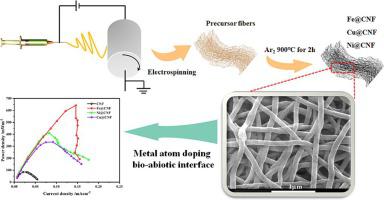当前位置:
X-MOL 学术
›
Bioelectrochemistry
›
论文详情
Our official English website, www.x-mol.net, welcomes your feedback! (Note: you will need to create a separate account there.)
Tuning metal atom doped interface of electrospinning nanowires to toward fast bioelectrocatalysis
Bioelectrochemistry ( IF 5 ) Pub Date : 2024-02-06 , DOI: 10.1016/j.bioelechem.2024.108664 Wen Lin , Shuang Wu , Tianyu Tang , Yongquan Liao , Wenting Miao , Zhuanzhuan Shi , Xiaoshuai Wu
Bioelectrochemistry ( IF 5 ) Pub Date : 2024-02-06 , DOI: 10.1016/j.bioelechem.2024.108664 Wen Lin , Shuang Wu , Tianyu Tang , Yongquan Liao , Wenting Miao , Zhuanzhuan Shi , Xiaoshuai Wu

|
Metal doping plays a key role in overcoming inefficient extracellular electron transfer between electrode interface and electricity-producing microorganisms. However, it is unknown whether different metals play distinctive roles in the doping process. Herein, three different metal ions (Fe, Ni and Cu) are added to the spinning precursor to obtain the corresponding electrospinning metal doped carbon nanofibers. It is found that the maximum output power of iron doped carbon nanofiber anode is 641.96 mW m, which is better than that of nickel doped carbon nanofiber (411.26 mW m) and copper doped carbon nanofiber (336.01 mW m), as well as 7.62 times higher than that of CNF. The results proved that due to the various number and types of active sites formed, as well as the distinction in surface morphology and structure, the electronegativity of each material is different. The different bio-abiotic interface could affect the direct contact between the anode interface and the extracellular protein of electricity producing microorganisms, which leading to a significant gap in the improvement of bioelectrocatalytic performance of different metal anode materials. This work provides a synthetic idea for designing highly efficient anode materials with directional metal modification and interface regulation.
中文翻译:

调整静电纺丝纳米线的金属原子掺杂界面以实现快速生物电催化
金属掺杂在克服电极界面与产电微生物之间低效的细胞外电子转移方面发挥着关键作用。然而,尚不清楚不同的金属在掺杂过程中是否发挥不同的作用。在此,将三种不同的金属离子(Fe、Ni和Cu)添加到纺丝前驱体中以获得相应的静电纺丝金属掺杂碳纳米纤维。结果发现,铁掺杂碳纳米纤维阳极的最大输出功率为641.96 mW·m,优于镍掺杂碳纳米纤维(411.26 mW·m)和铜掺杂碳纳米纤维(336.01 mW·m),以及7.62倍。高于CNF。结果证明,由于形成的活性位点数量和类型不同,以及表面形貌和结构的区别,每种材料的电负性不同。生物-非生物界面的不同会影响阳极界面与产电微生物胞外蛋白的直接接触,导致不同金属阳极材料生物电催化性能的提升存在显着差距。这项工作为设计具有定向金属改性和界面调节的高效阳极材料提供了综合思路。
更新日期:2024-02-06
中文翻译:

调整静电纺丝纳米线的金属原子掺杂界面以实现快速生物电催化
金属掺杂在克服电极界面与产电微生物之间低效的细胞外电子转移方面发挥着关键作用。然而,尚不清楚不同的金属在掺杂过程中是否发挥不同的作用。在此,将三种不同的金属离子(Fe、Ni和Cu)添加到纺丝前驱体中以获得相应的静电纺丝金属掺杂碳纳米纤维。结果发现,铁掺杂碳纳米纤维阳极的最大输出功率为641.96 mW·m,优于镍掺杂碳纳米纤维(411.26 mW·m)和铜掺杂碳纳米纤维(336.01 mW·m),以及7.62倍。高于CNF。结果证明,由于形成的活性位点数量和类型不同,以及表面形貌和结构的区别,每种材料的电负性不同。生物-非生物界面的不同会影响阳极界面与产电微生物胞外蛋白的直接接触,导致不同金属阳极材料生物电催化性能的提升存在显着差距。这项工作为设计具有定向金属改性和界面调节的高效阳极材料提供了综合思路。



























 京公网安备 11010802027423号
京公网安备 11010802027423号